Diplomat Chess
Introduction
Diplomat Chess is a game played on a board with 43 cells arranged in the shape of a disk. Its cells are organised in 14 radii and 4 circular crowns. Each radius contains 3 cells, and each crown contains 14 cells, with the exception of the 4th crown, which is only formed by one cell, called the centre. This cell represents the central hole of a disk (think of a CD, hehe) and has special properties.
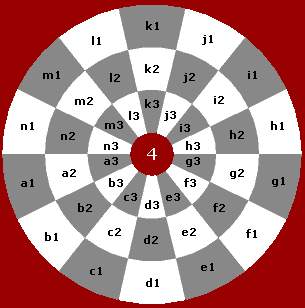
Each radius is named with a lowercase letter from a to n; each crown is named with a number from 1 to 4. As you see in the example above, all cells are named with the letter of the radius they belong to, plus the number of the crown they belong to (for example c2). The only exception is the centre, which is noted simply with the number 4, since it alone forms the 4th crown, and belongs to none of the radii.
The centre is considered to be both orthogonally and diagonally adjacent to all cells in the 3rd crown. Thus, the pieces' movements vary when they begin or end in the centre (but always within the logic that defines that piece's movement). It is advisable that the centre be a hole in the board, to make clear the fact that it is neither a light-coloured nor a dark-coloured cell; but it is a cell, actually, and may be entered by any piece that is able to do so.
Setup
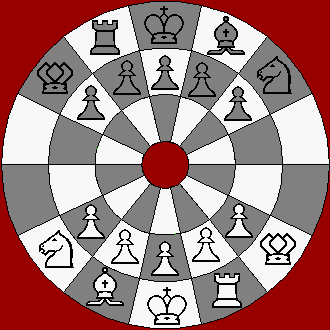
Above you can see the initial setup of the pieces.
(Note: the graphics on this page use piece symbols from the Alfaerie graphics set by David Howe, using the Falcon symbol for the diplomat.)
The initial set of pieces is:
White:
King on d3
Rook on e3
Diplomat on f3
Bishop on c3
Horse on b3
Pawns on b2, c2, d2, e2 and f2.
Black:
King on k3
Rook on l3
Diplomat on m3
Bishop on j3
Horse on i3
Pawns on i2, j2, k2, l2 and m2.
One of the peculiarities of this board is the fact that there are two ways of advancing: radially and circularly. Radial movements are orthogonal movements within the same radius, circular movements are made within the same crown. These two types of approaching the enemy determine two ways of playing, depending on how you want to imagine the board (since pawns can advance in both orthogonal ways):
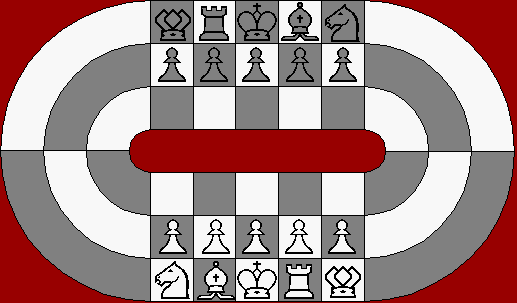
Radially, you can imagine the board as a frontal battle between the black and white armies. To approach your enemy radially, all your pieces have to pass through the centre of the board.
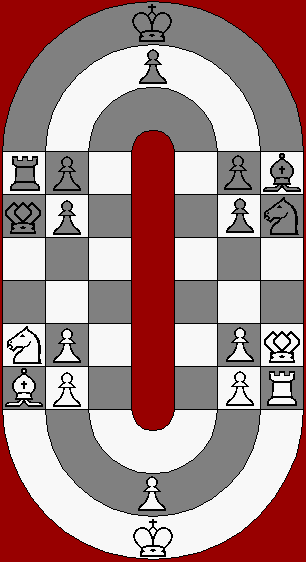
But you can also imagine the board >circularly; in this case there will be two fronts between the wings of the armies, and the pieces will advance towards the enemy avoiding the centre and surrounding it.
During the game, it is not advisable to concentrate in only one of these two forms of playing, although the moves tend to be radial rather than circular, because the control of the central cell (which is important in most chess-like games) in Diplomat Chess is essential due to the special properties that the central cell has.
Pieces
Each army starts with ten pieces: a King, a Bishop, a Rook, a Horse, a Diplomat and five Pawns. All these have a chess counterpart, except the Diplomat, after which the game is named.
The Pawn

The pawn moves one step orthogonally forward and catures to one step diagonally forward (following the logic of chess). But the strangeness of the board makes it necessary to further define what we understand as forward.
Examples of movement: in all the following examples the pawns are going to be white, and the color of the circles will mean:
Black - Cell where the pawn currently is
Green - Cells that the pawn can move to without capturing
Red - Cells in which the pawn can capture an enemy piece
Green/Red - Cells where the pawn can move to, no matter whether it captures or not
Blue - Cells where a pawn promotes
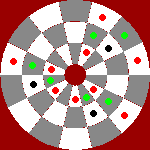
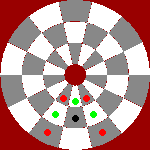
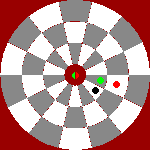
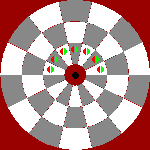
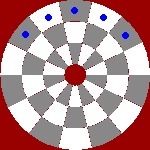
We could define a forward movement as one that places the pawn closer to the starting cell of its enemy king. A pawn in a normal position has two movement options: moving circularly forward or radially forward (toward the centre when it is in its own territory, outwards when it is in enemy territory). White's territory are radii a to g; black's territory are radii h to n. Then pawns can capture to the sides of the cells they can move to (either from the circular or from the radial point of view).
In the second image you can see an example of the movement of a pawn on a central radius (radii d and k). There is no forward circular direction defined for it yet, so in this case the pawn has three move options (but once it chooses one circular direction, either clockwise or counterclockwise, it will have to keep on moving that way circularly).
The third and fourth images only show the consequences of the central cell being both radially and diagonally adjacent to all cells in the 3rd crown. As you see, pawns have increased powers when they are in the centre. In this game, all pieces have increased powers when in the centre, although that is a risky position where they are exposed to more attacks.
Finally, the last image shows the cells a pawn has to reach to promote. They are, like in chess, the starting cells of the enemy's non-pawn pieces. Pawns can promote into any non-pawn, non-king piece, as usual.
The Bishop

The bishop moves any number of unobstructed squares diagonally, exactly as its chess counterpart. But the strangeness of the board makes it necessary to explain some of the bishop's features in this game.
Examples of movement: in all the following examples (for the bishop and all the following pieces too) the color of the circles will mean:
Black - Cell where the piece currently is
Red - Cells that the piece can move or capture to
Only for the bishop, red lines show one of its movement's paths.
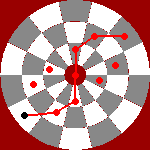
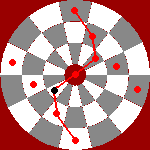
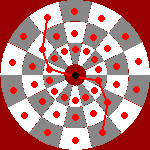
The bishop moves diagonally outwards until it reaches the outer side of the board, or diagonally inwards until it reaches the centre. When it passes through the centre, the bishop exits it by the cell opposite to where it had entered (both cells will be in the 3rd crown and have different colours). Then the bishop continues moving diagonally outwards.
Like all pieces, a bishop in the centre is extremely powerful. Please note that bishops are not isochromatic (colourbound) in this game, so there is no need of having two bishops on each side.
The Rook
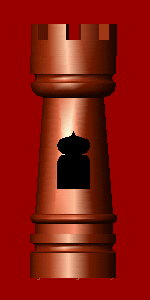
Like its chess counterpart, the rook moves any number of unobstructed squares orthogonally (in this case, radially or circularly).
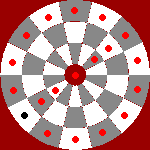
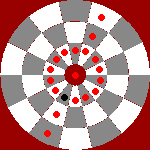
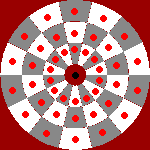
For a rook in an empty crown, it is forbidden to move all the way along the crown and then end up at its starting position (with the same result as if it had not moved at all!). Such null movements are illegal in this game.
The Horse

The Horse is the equivalent of the standard chess piece called the Knight. The first reason for the change of the name is that with this new name we could use the first letter of the names of all pieces to represent them in notation, whereas the name knight would have had the same initial letter as the king. The second reason is that horse is the literal translation of the name chess knights are given in Spanish: caballo (in Spanish notation all pieces are represented with the first letter of their names, since they all begin with different letters, and that seems to be more adequate).
Despite its different name, the horse moves exactly as the knight in chess does. This is, the horse jumps from its starting cell and lands on one cell that is an orthogonal plus a diagonal move away. Its like if the horse moved first one space orthogonally, then another one diagonally away from its starting position (or first diagonally and then orthogonally). The only difference is that the horse jumps: this means that it moves regardless of the intervening pieces. Bishops and rooks see their movements blocked by obstacles, while horses do not. There are no obstacles (neither friendly nor enemy pieces) for the horse; it jumps over them.
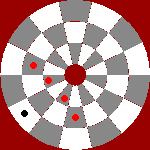
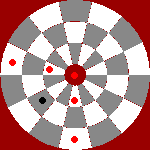
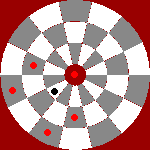
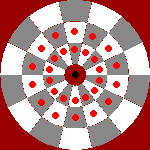
The Diplomat

The Diplomat is the strangest piece of this game, and the only one that has no corresponding piece in standard chess. Also the fact that it cannot capture enemy pieces but suborn them makes this piece quite peculiar. The diplomat is a weird piece, very different from the others, that has its own charm. It is a distinctive feature of this game, and the reason for its name.
The diplomat moves passively exactly as the king does, i.e. it can enter any adjacent cell (circularly, radially or diagonally) that is unoccupied. The only difference is that the diplomat cannot capture enemy pieces.
Instead of capturing enemy pieces, the diplomat can suborn them. This means that the enemy piece is corrupted and leaves its side, passing to the diplomat's side (the piece changes colours). For example, a white diplomat may suborn a black rook. The black rook becomes white, and the white player can move it on his next turn. Suborning enemy pieces can be considered to be more profitable than capturing them, since not only does you enemy's side lose a piece, but your side gains one as well.
The diplomat has the ability to suborn enemy pieces situated in cells that it could move to (adjacent cells). The whole procedure is very similar to a capture. The diplomat moves to a cell where there is an enemy piece already. Then, that piece is induced to switch colours (by means of the diplomatic talents of the diplomat), becoming one more of the pieces on the diplomat's side. The main difference is that, since the diplomat cannot replace the corrupted piece, it returns to its starting position. After the turn the diplomat appears to remain on the same cell where it was standing before, and the only thing that has happened is that one piece has changed its colour.
The only piece who cannot be corrupted by the diplomat is the enemy king. All other pieces, including the enemy diplomat itself, can be induced to betrayal (you see in this game pieces are a kind of mercenaries - they pretend they are fighting for their sides' ideals or for loyalty to their kings until the enemy diplomat offers them a certain sum of money; then they blissfully abandon their army and become traitors). Nevertheless, the diplomat can do no harm to the enemy king.
The diplomat may suborn only one piece at a time. If there are two or more pieces adjacent to it at the beginning of its turn, the diplomat must choose one of them.
In notation, suborn is represented by the destination cell, followed by the equal symbol (=) and then the name of the colour the suborned piece changes to, for example: b3=black (There is no need of writing the letter D for the diplomat). In order to shorten notation, the words black and white can be replaced by their initial letters b and w, thus: b3=b.
The King
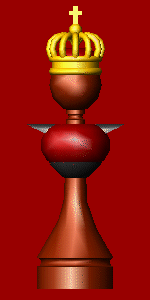
The King is the most important piece of the game, and has remained unchanged in most chess variants. It is a royal piece, actually the only royal piece in the game, so the match is won by checkmating or stalemating your enemy's king.
The king moves, and captures, to any adjacent cell. This means that the king can go to any cell that is in contact with its present cell (whether circularly, radially or diagonally). You cannot move your king to a cell where it would be in check. Actually, you cannot move any of your pieces in such a way that you leave your king in check, since such movements would be illegal.
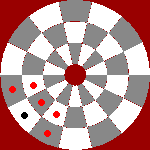
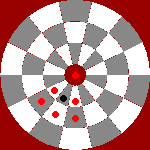
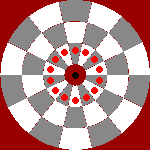
Rules
White moves first.
In this game I found that pawns did not take too much to get into fight, so there was no need of the initial double-step move, and, consequently, there are no en passant captures. Also, there is no castling in Diplomat Chess.
The game is won by checkmating or stalemating the enemy king.
When both kings are bared (i. e. they are the only remaining pieces on the board) the game is automatically declared a draw. The same happens when one position is repeated three times.
Null movements (for example, a rook moving all the 360º way round an empty crown) are illegal and cannot be used to relieve stalemate.
Notes
I have found some similarities with the board of this game and some circular chess variants, like the Byzantine Chess. Especially, I found that the games By Rook or By Crook by Jeff Rients and Flipworld by John Ryan were played on boards that somehow resemble the >Diplomat Chess board (Ryan even names vector and circuit what I here call radius and crown); but the game itself is actually quite different. I have never seen anything like my diplomat piece (which comes from an idea I had some time ago) anywhere.
If you want to know more about this game, you can go to a special website I designed for it HERE. Feedback is appreciated!
Playing Tips
If you play this game, which I would like to encourage you to do, you may find that the diplomat is more valuable than it may seem at first sight. It might prove to be the strongest piece of the game.
If you can place any piece in the centre so that your enemy cannot capture it (which is far more difficult than it sounds) you have almost won, since pieces in the centre have increased powers. Actually, this game is another variant on the importance of the control on central squares, which is a theme that is usually present in many chess variants.
You will not probably place your diplomat on the very centre, but use it to control the central cell from the 3rd crown.
When pieces start going to the centre and leaving the 1st crown (which they tend to do), be careful about rooks and pinned pieces.
Normally, kings will not be used to attack, but they can be used to keep diplomats at bay (since they are inmune to suborn) or to prevent pawns from promoting.
Possible Subvariants
Despite the game as it stays is the main variant that shall be judged at the contest, other subvariants are possible to play this game. For example, you can set as a rule that suborned pieces are taken off the board (the diplomat remains a powerful piece, because it has the ability to capture pieces without entering their cell, so it can capture protected pieces too).
Even better, you can decide that suborned pieces are taken off the board and later dropped on it. If you play the game with drops, the rules for dropping a piece are:
-You can only drop pieces into empty squares,
-You cannot drop a piece in the center,
-You cannot drop a piece so that it checks the enemy king, and
-Pawns cannot be dropped into promoting squares.
Equipment
This game can be played with a standard chess set, as long as you use each queen piece for the diplomat.
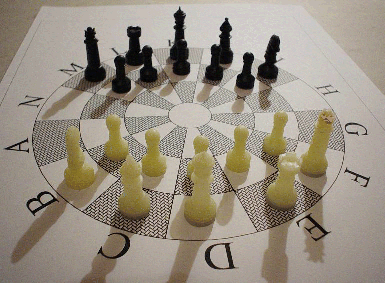
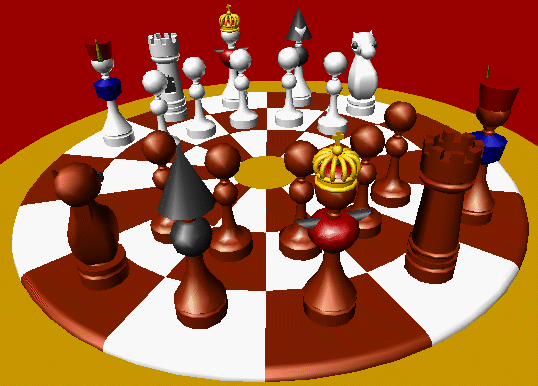
If you ever have the idea of building a board, I recommend you to make the 3rd crown cells as exaggeratedly big as possible. You may find that, contrary to what they seem, they are never big enough (hehe). Also, to make the bishop's movement through the centre more clear, you can paint the inner side of the cells a3 to g3 in seven different colours (for example, those of the rainbow) and cells h3 to n3 in the same corresponding colours; thus, the bishop enters and leaves the centre by cells whose inner sides have the same colour.
Sample Game
This is a sample game I display here for those who are interested in seeing some game features, like the diplomat's suborn, or whatever else, in a real game. However, the players by no means claim to be good at this game. This has been chosen as a sample because of its interest as source from which you can learn tips for playing Diplomat Chess, and you may find that some movements are not probably the best that could have been made, being replaced by more interesting ones.
Players who are accustomed to standard chess notation, may be shocked by the notation of the cell 4, whose name is only a number, and also by seeing pieces in the centre have transparent background (instead of light- or dark-coloured).

1. d3, k3
2. e3, l3
3. Ha3, Dn2
4. d-4, a3=black
5. bxa3, a3=black
(This is an example of the diplomat's power. It allows us to control a certain cell, no matter how many of the enemy's pieces are attacking that cell.)
6. f-f3, Da2
(If 6. Bxf3, then 6. ..., f3=black)
7. Dg1, i3
8. c3, Db3
9. Kc2,
(The king is inmune to suborn.)
9. ..., lx4
10. Dh1, Hj3
11. Dg2,
(Note that the black bishop is pinned.)
11. ..., 4xf3
12. f3=white, k-4
13. Df2,
(White pieces dare not capture to the centre, because of the black diplomat.)
13. ..., c3=black
14. De2, a2
15. Bd2,
(White would lose a bishop in exchange of an enemy pawn, but also gain a pawn.)
15. ..., a1
(Black refuses the trading of pieces, anyway.)

16. Kb1,
(To prevent the black pawn from promoting.)
16. ..., 4xe3
17. Bxe3, i-4
18. Ka2,
(The black pawn on a1 is protected by the black rook.)
18. ..., Db2
(In order to win control over b1.)
19. fx4,
(Now that the black diplomat does not control the centre.)
19. ..., Hh2
20. m3, b1=Rook
(The black pawn promotes into a second rook.)
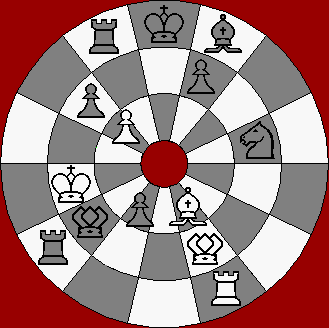
(The black rook on b1 and the white rook on e1 are protected by their corresponding diplomats.)
21. Bxm2, H4+
(The only possibility is:)
22. Bx4, Rx4+
(Again, the only escape is:)
23. Kxb1, Da1+
24. Kc2, d3+
25. Kd2,
(The other possibility was Kd1, but white cannot avoid checkmate)
25. ..., dxe2++
Checkmate
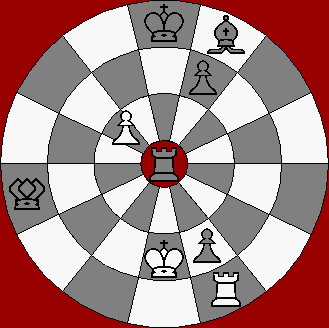
Written by Carlos Martín-Fuertes Moreno.
WWW page created: April 7, 2003.
